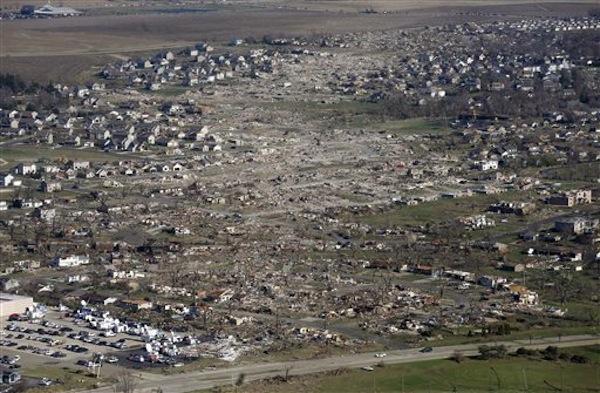
No tornadoes have been reported this year, except in the far Southeastern U.S. Historically, the heart of the Illinois tornado season is March to June. In the past few years, however, Illinois has had more tornadoes occur outside of this period than inside.
In addition, many of these tornadoes have been concentrated in just a few days of the year. In fact, 69 percent of tornadoes in 2012-14 occurred in just five days.
In 2012, drought was the big story, Angel said. Typically, drought years tend to have lower tornado counts: fewer thunderstorms lead to fewer tornadoes. Out of only 15 reports in 2012, seven of those occurred on Feb. 29 (a leap year). As the drought became widespread in March through August, the tornado count plummeted.
The year 2013 was a quiet year until the massive tornado outbreak of Nov. 17.
Comment: 2013 was one of the quietest tornado seasons in 40 years, until 43 tornadoes ripped through Illinois:
On average, the entire United States usually gets hit with 35 tornadoes in November. Only seven tornadoes on average occur in Midwestern states in November, and only one on average strikes Illinois in November.
"This is why a quiet tornado season can lead to a false sense of security," Angel said. "All it takes is one day with the right conditions for all that to change."
Last year, 2014, was a moderate year with 35 tornado reports. However, 82 percent of those occurred on just three days: Feb. 20 (10), June 30 (10), and Oct. 13 (8). As in the other years, two of these outbreaks occurred outside of the traditional tornado season.
When 2012, 2013 and 2014 are combined, the distribution of tornadoes by month does not match our idea of the tornado season. In fact, the busiest month by far was November with February in second place and October in fourth place.
Is this a signal of climate change?
Comment: Probably, but it really depends on what kind of climate change we're talking about:
- The fallacy of "climate change"
"It is hard to say at this point because it is too short of a record to draw conclusions," Angel said. "In addition, this analysis is just for Illinois. Changes in Illinois could be offset by changes elsewhere in the U.S."
Even if the change is short-term, the need to stay vigilante for tornado watches and warnings, regardless of the time of year, is important, Angel concluded.



Reader Comments
to our Newsletter